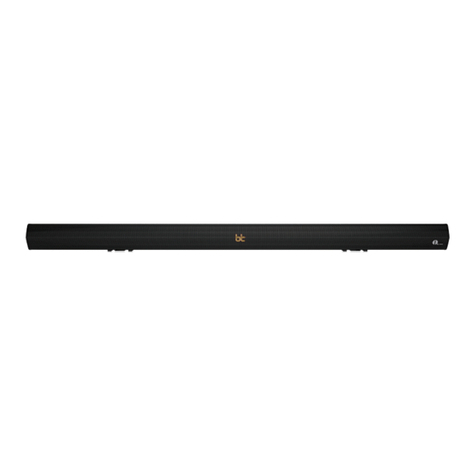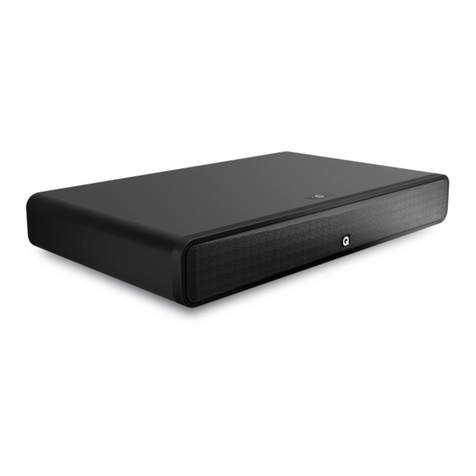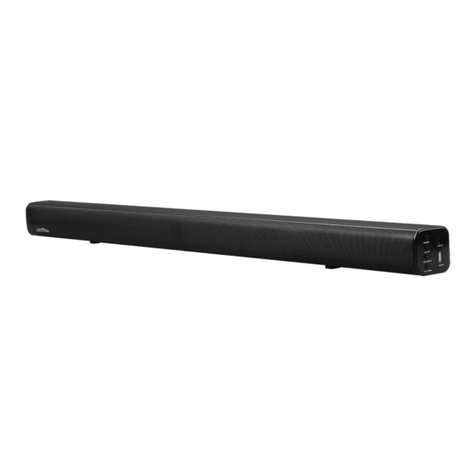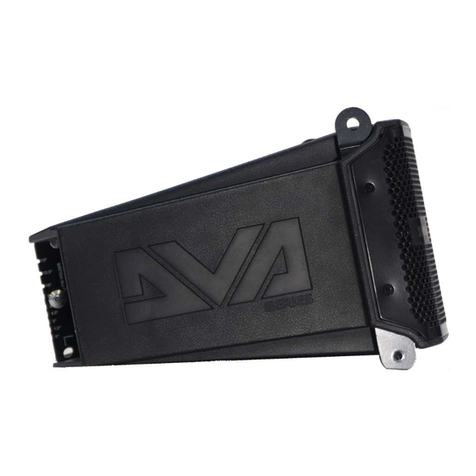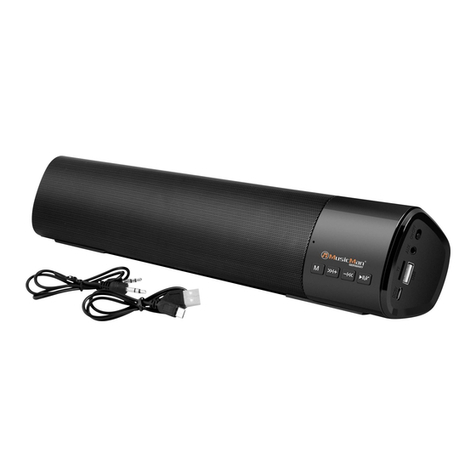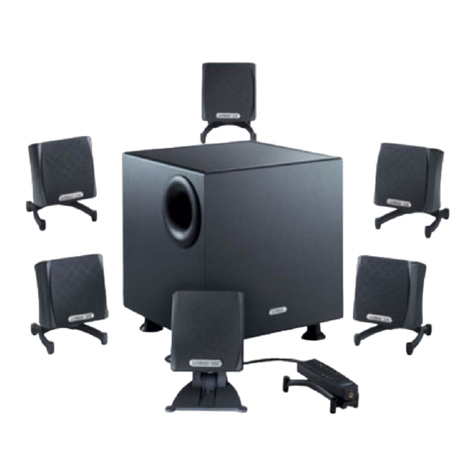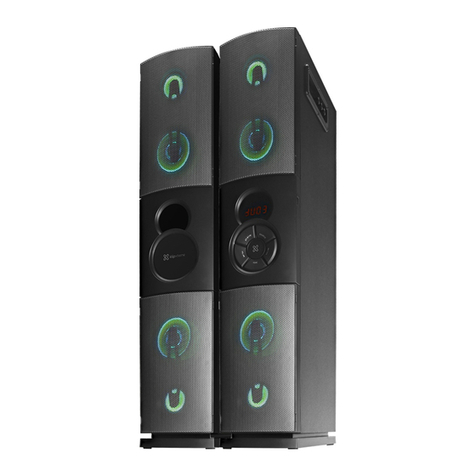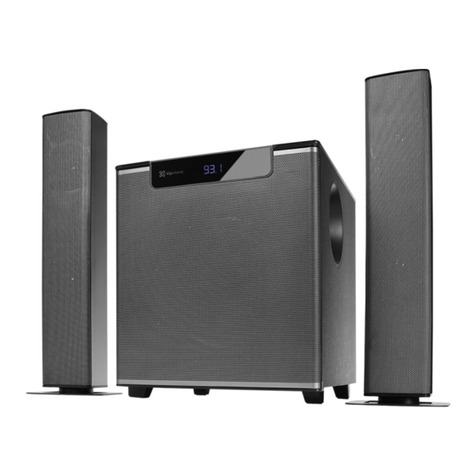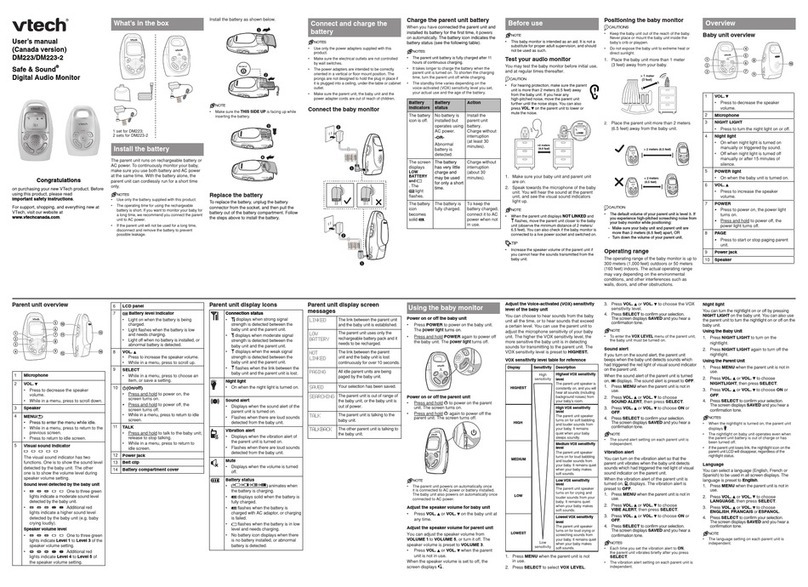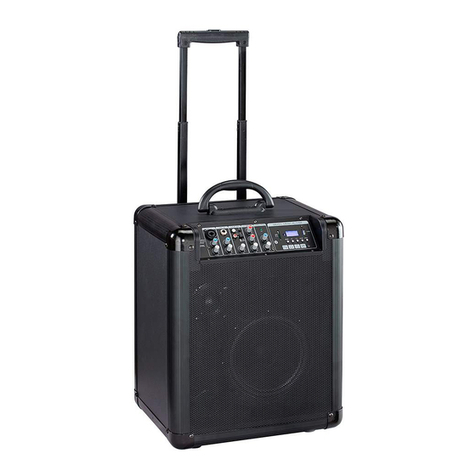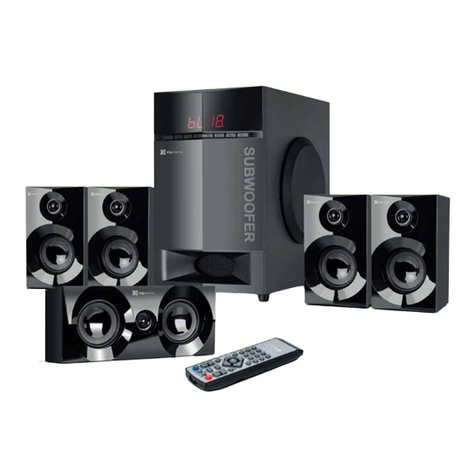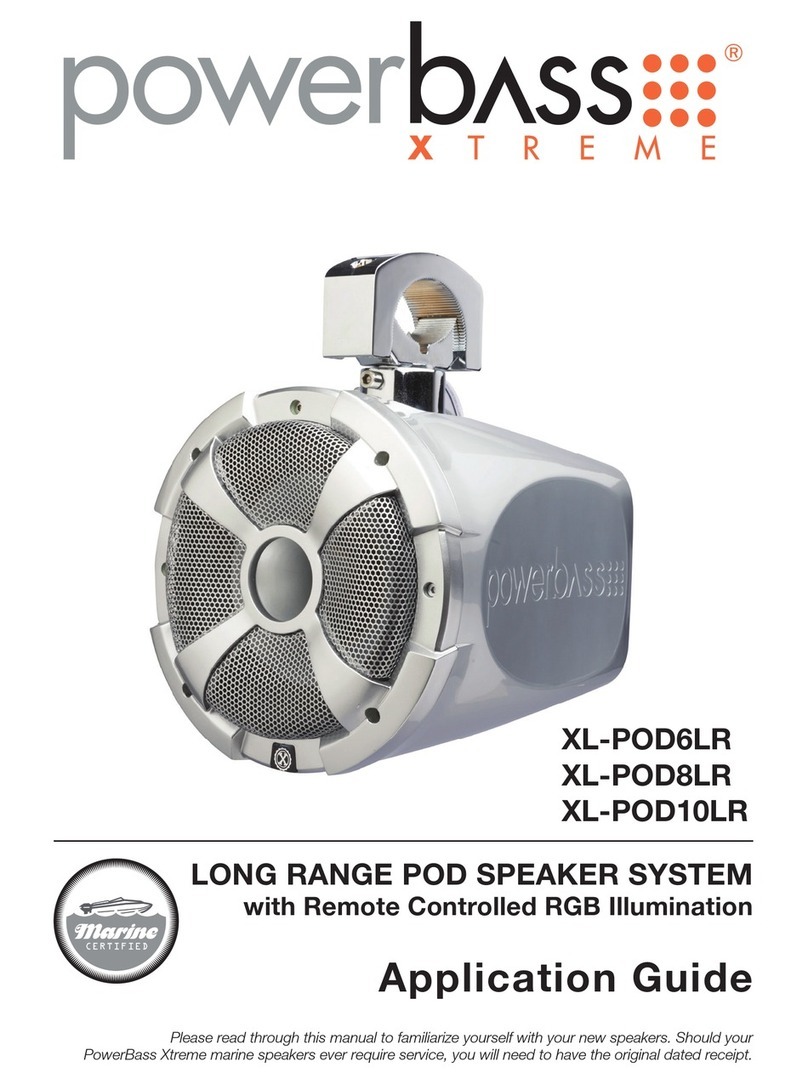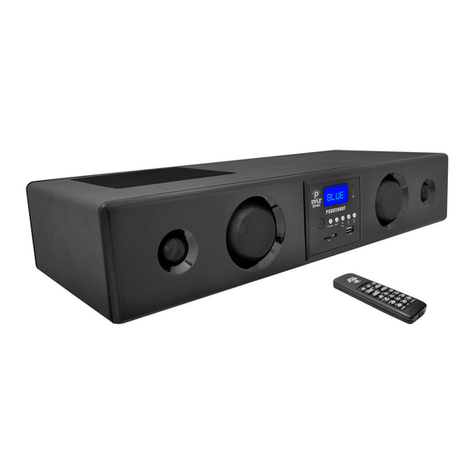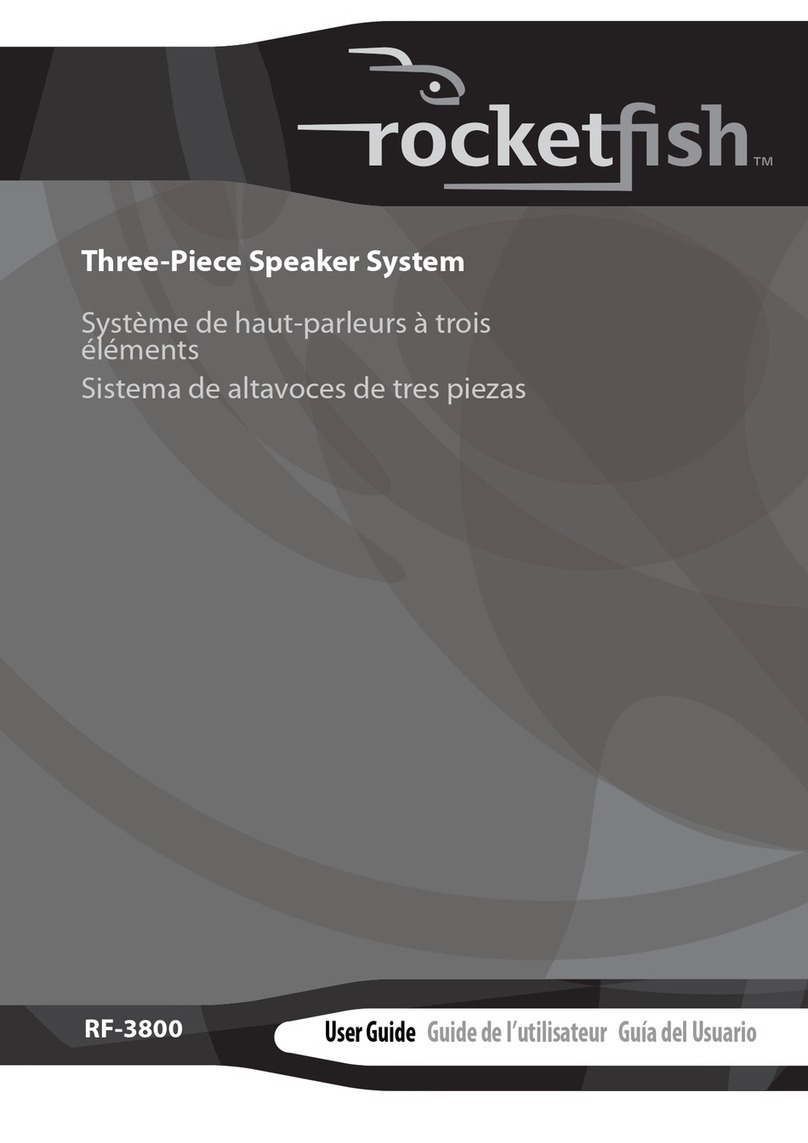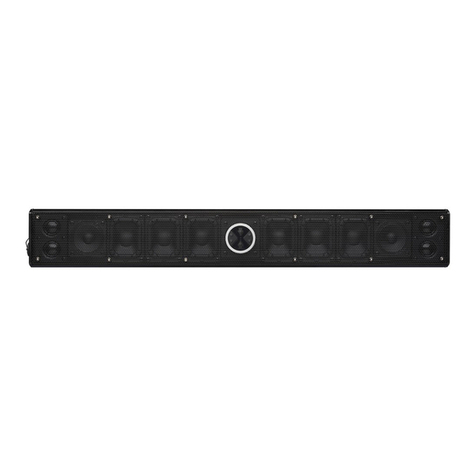Bohlender-Graebener Radia R-50 User manual

© Copyright 2003 Bohlender-Graebener Corp. All rights reserved. Products, features and specifications subject to change without notice.
A Division of Bohlender-Graebener Corp.
Guide To
System Design &
Installation
•••
High Performance
Home Entertainment Environments
radia
the
series

Table of Contents
Section 1 An Introduction to The Radia Series
•Advantages of the planar-magnetic, line-source speaker system
Section 2 Technical Description
Section 3 Questions and Answers
•How do the Radia Series components solve specific acoustical problems?
•What installation advantages do the Radia Series systems offer?
Section 4 Line-Source Speaker Use and Operation
•The Radia Series line-source speakers in vertical applications
•The Radia Series line-source speakers in horizontal applications
Section 5 Installation
•Installing the Radia Series planar speaker
© Copyright 2003 Bohlender-Graebener Corp. All rights reserved. Products, features and specifications subject to change without notice.
the radia series
the radia series

Section 1
An Introduction to The Radia Series
Advantages of the planar-magnetic, line-source speaker system
The most significant benefit a speaker system can offer is sonic accuracy. Yet an analysis of any speaker design
reveals the inevitable compromises that the designer has considered and accepted as part of the finished
product. High-performance systems are the result of wise choices made by the design team based on their
perceptions of the interaction between speaker, environment, and listener. Unwise design choices will result
in speaker systems that do not completely serve the human need in the reproduction of music or other
auditory program.
Additionally, any room in which speakers are located is part of the system and influences the performance of
the speaker system. The acceptance of room limitations may be one of the first significant steps in the design
of a successful speaker system.
The Radia Series of high-performance, planar-magnetic speaker systems from Bohlender-Graebener
Corporation are among the most accurate and satisfying speaker systems ever developed for home or
commercial environments. Incorporating wise design choices, which include the influences of listening
space, The Radia Series represents a true departure from design technologies which have been considered
the norm for decades.
•Ultra-light diaphragm responds instantly; the sound is fast, open, and dynamic in the tradition of the
finest audiophile-quality speaker systems.
•One-way, crossover-less operation above 275 Hz gives seamless, transparent sound.
•Wide horizontal dispersion eliminates placement problems and stereo image inconsistency.
•Natural vertical directivity ensures an almost complete lack of ceiling and floor “bounce” in the
frequencies above the crossover point.
•Large speaker size and enormous power handling produce an unmatched image size, weight, and
impact.
•Moderate load to the amplifier eliminates problems based on amp or cable limitations.
Combining these performance advantages with exceptional installation possibilities allows an unmatched
opportunity for the integration of high sound quality and cosmetic elegance in premium entertainment systems.
© Copyright 2003 Bohlender-Graebener Corp. All rights reserved. Products, features and specifications subject to change without notice.
the radia series
the radia series

Section 2
Technical Description
The Radia Series planar-magnetic speaker is an extremely high-quality, durable device developed over a
period of more than ten years. The operating principle is one in which the magnetic circuit, or motor, drives
the radiating surface directly, rather than through an indirect path from voice coil to former to cone or dome.
The mass of the diaphragm is less than the air that it drives, which ensures tremendous detail, transparency,
and control. Using an advanced push-pull motor, The Radia Series speaker’s
performance is further enhanced by virtue of its highly linear drive principle,
whereby force on the diaphragm is applied in an absolutely uniform
fashion.
The Radia Series planar-magnetic drivers have an aperture width of only
1.25” and thus have wide horizontal coverage, eliminating the trial-and
error common to planar-magnetic and electrostatic speaker placement.
R-series products under the Radia Series brand are complete systems. Each
contains a planar-magnetic driver and complimentary midbass system with
integrated passive crossover network. All are compatible with current home
theater standards.
© Copyright 2003 Bohlender-Graebener Corp. All rights reserved. Products, features and specifications subject to change without notice.
the radia series
the radia series
Model R-50

Section 3
Questions and Answers
How do The Radia Series components solve specific acoustical problems?
Conventional point-source speakers radiate sound in a spherical pattern, thereby directing substantial
acoustical energy outside of the immediate listening area and causing undesirable ceiling and floor reflections.
•Because of their line-source operating principle, the ribbon component in each Radia Series speaker
directs sound only into the listening area, eliminating ceiling and floor reflections. This substantial
advantage is made possiblewithout the use of multiple tweeters or other controversial techniques.
•The Radia Series systems guarantee high power handling to above 500 watts per channel, making them
very useful for full-sized home theater installations. High output capability means that The Radia Series
speaker systems also eliminate inadequate image size and inadequate playback volume distortions.
•Conventional speaker systems attenuate (reduce volume) at a rate of -6 decibels (a measured
reduction of acoustic power of 4 times) every time the distance to the speaker is doubled. The Radia
Series line-source ribbons attenuate their volume over distance at half this rate, or -3 decibels per
doubling of distance. This allows for much more consistent coverage and a significant reduction of
listener fatigue due to both excessive volume close to the speaker and insufficient volume farther
back in the audience. Conventional speakers cannot deliver the resulting sonic realism.
•The Radia Series line-source speakers also operate as one-way speakers above their bass crossover
point, thereby achieving the ideal of coherent, consistent amplitude (loudness) and phase response.
© Copyright 2003 Bohlender-Graebener Corp. All rights reserved. Products, features and specifications subject to change without notice.
the radia series
the radia series

the radia series
the radia series
© Copyright 2003 Bohlender-Graebener Corp. All rights reserved. Products, features and specifications subject to change without notice.
Section 3,cont.
What installation advantages do The Radia Series offer?
The installation of modern audio systems frequently calls for meticulous attention to cosmetic design. The
Radia Series offers the designer the ability to reach maximum high-performance specifications while
simultaneously providing an absolute minimum of cosmetic intrusion.
•R-Series Systems installed with drywall grilles measure less than common, low-performance 6” in-wall
speakers in the critical width dimension, freeing space for furniture or decorative items.
•In custom designs, The Radia Series systems install in vertical details in cabinetry in as little as 7”
of width for the ultimate performance and elegance.
The Radia Series speakers virtually disappear, while still providing state-of-
the-art performance – performance absolutely unavailable from miniaturized
“architectural” speaker systems.
6” 8” 10” 7”
5” Inwall
6” Inwall
8” Inwall
Model R-50
or R-75

Section 4
Line-Source Speaker Use and Operation
The Radia Series line-source speakers in vertical applications
The R Series speakers contain planar-magnetic transducers that behave as line-source speakers distinctly
different from point-source speakers. Careful system design will exploit this characteristic for demanding
installations where highly specific and uniform sound coverage is required.
The primary characteristic of which the system designer must be aware is the radiation pattern of line-source
transducers that radiate sound from a seemingly infinite number of points. The perception is that sound is
being emitted by the speaker only from the point exactly perpendicular to the listener. The sound source
largely disappears when the listener, by moving beyond either end of the speaker, leaves a position at right
angles to the face of the speaker. Simultaneously, the dispersion across the narrow width of the speaker
approaches 180 degrees. The cylindrical wavefront propagated expands uniformly across the audience.
Installed vertically, the R Series speakers behave in their most conventional way, radiating sound from
below 60 Hz to 18.5 kHz (+/- 3 dB) with wide horizontal dispersion - making them ideal for 5.1, 7.2 or better
Home Theater and DVD Audio format playback. Used singly, the R Series speakers can address an audience
with unmatched intelligibility. Used in multiples around an audience they can broadcast multi-channel audio,
stereo, surround, or other matricies to an audience with maximum fidelity.
As noted previously, a significant characteristic of the line-source speaker is its ability to maintain an SPL over
distance that attenuates only half as much as a point-source speaker (horn, cone, dome, etc.) that is, at a rate
of -3 dB per doubling of distance. Because the line-source radiates sound as an expanding cylinder and not
as an expanding sphere, the -3 dB phenomenon may result from an absence of energy being radiated above
and below the ends of the speaker. The relative sensitivity of an 87dB line-source speaker measured beyond
4 meters is therefore greater than 90 dB/1w/1m. Relatively high SPLs at distance now does not mean excessive
SPL closer to the speaker. The cylindrical coverage of the R75, for example, minimizes lost acoustic and
amplifier power and unwanted sound energy beyond the immediate soundfield.
Using the directionality of The Radia Series allows unprecedented soundfield control. Extremely uniform
application of acoustic power will provide coverage and intelligibility unavailable from conventional speaker
systems. A demonstration is strongly suggested.
© Copyright 2003 Bohlender-Graebener Corp. All rights reserved. Products, features and specifications subject to change without notice.
the radia series
the radia series

Section 4,cont.
The Radia Series line-source speakers in horizontal applications
The R Series speakers contain planar-magnetic transducers that behave as line-source speakers distinctly
different from point-source speakers. Careful system design will exploit this characteristic for demanding
installations where highly specific sound coverage is required.
The primary characteristic of which the system designer must be aware is the radiation pattern of line-source
transducers that radiate sound from a seemingly infinite number of points. The perception is that sound is
being emitted by the speaker only from the point exactly perpendicular to the listener. The sound source
largely disappears when the listener, by moving beyond either end of the speaker, leaves a position at right
angles to the face of the speaker. Simultaneously, the dispersion across the narrow width of the speaker
approaches 180 degrees. The cylindrical wavefront propagated expands uniformly across the audience.
A thorough understanding of this phenomenon recommends against the use of a horizontally installed,
line-source speaker for a center channel system in home theater. (The R Series contains specific models
designed for center channel use - see the application chart.) Listeners placed within the ends of the
speaker will localize the center sound track at a position on the screen exactly perpendicular to them, perhaps
significantly off center. Listeners beyond the ends of the speaker will hear virtually nothing. Furthermore,
ceiling and floor reflections will become significant, resulting in diminished intelligibility. The benefits of the
vertical line-source speaker may become disadvantageous in a horizontally installed speaker.
For commercial projects, however, the horizontal line-source offers tremendous advantages. Installed
horizontally, this technology will produce the effect of a “travelling sound source”, radiating sound from
150 Hz to 18.5 kHz (+/- 3 dB), while the apparent source “moves” with the listener along the length of the
speaker. Multiple speakers can be used end-to-end for high program intelligibility along an indefinitely long
field. The listener perceives the sound source moving with him, always exactly at right angles to the speaker’s
location.
Using the directional control available from The Radia Series allows unprecedented soundfield control.
Extremely uniform application of acoustic power will provide coverage and intelligibility unavailable from
conventional speaker systems. A demonstration is strongly suggested.
© Copyright 2003 Bohlender-Graebener Corp. All rights reserved. Products, features and specifications subject to change without notice.
the radia series
the radia series

the radia series
the radia series
© Copyright 2003 Bohlender-Graebener Corp. All rights reserved. Products, features and specifications subject to change without notice.
Section 5
Installation
Installing the Radia Series planar speaker
As with all acoustic suspension speakers, maximizing the performance of an in-wall or in-cabinet speaker
installation requires complete dissipation of the rear wave into a properly prepared back enclosure. Improperly
designed enclosures will prevent the speakers from reaching their intended 60 Hz crossover frequency and will
result in non-flat response curves.
•First, plan a speaker cavity of at least 51 square inches in cross-section (width times depth). The
height of the cavity must be at least equal to the length of the speaker. A good rule of thumb is to
use an enclosure no smaller than the standard 2x4 stud cavity on 16” centers. Prepare any
cabinet installation with at least this enclosure size in mind - for example, an enclosure for an 77”
tall system (such as the R75 or R50) would need to have a volume of at least 51x77 = 3,927 cubic
inches (2.3 cubic feet). Larger enclosures can be used with no detrimental effects, but smaller
enclosures will limit low frequency performance. Sealing holes and joints whenever possible will
also enhance low frequency performance.
•Second, always fill the entire enclosure with slightly compressed fibrous tangle as would be found
normally in a speaker enclosure (Fiberglas insulation, Dacron, Miraflex, wool, etc.). Avoid hard
acoustic panels.
•Third, wherever possible, prepare for the installation by first installing a shear surface beneath the
drywall. R-series speakers are relatively heavy and are capable of emitting high sound pressure levels.
A 1⁄4or 3⁄8inch plywood sub surface with a speaker cutout will also enhance the system’s performance.
;;;;;;;;
;;;;;;;;
Cross-sectional view
This manual suits for next models
1
Table of contents
